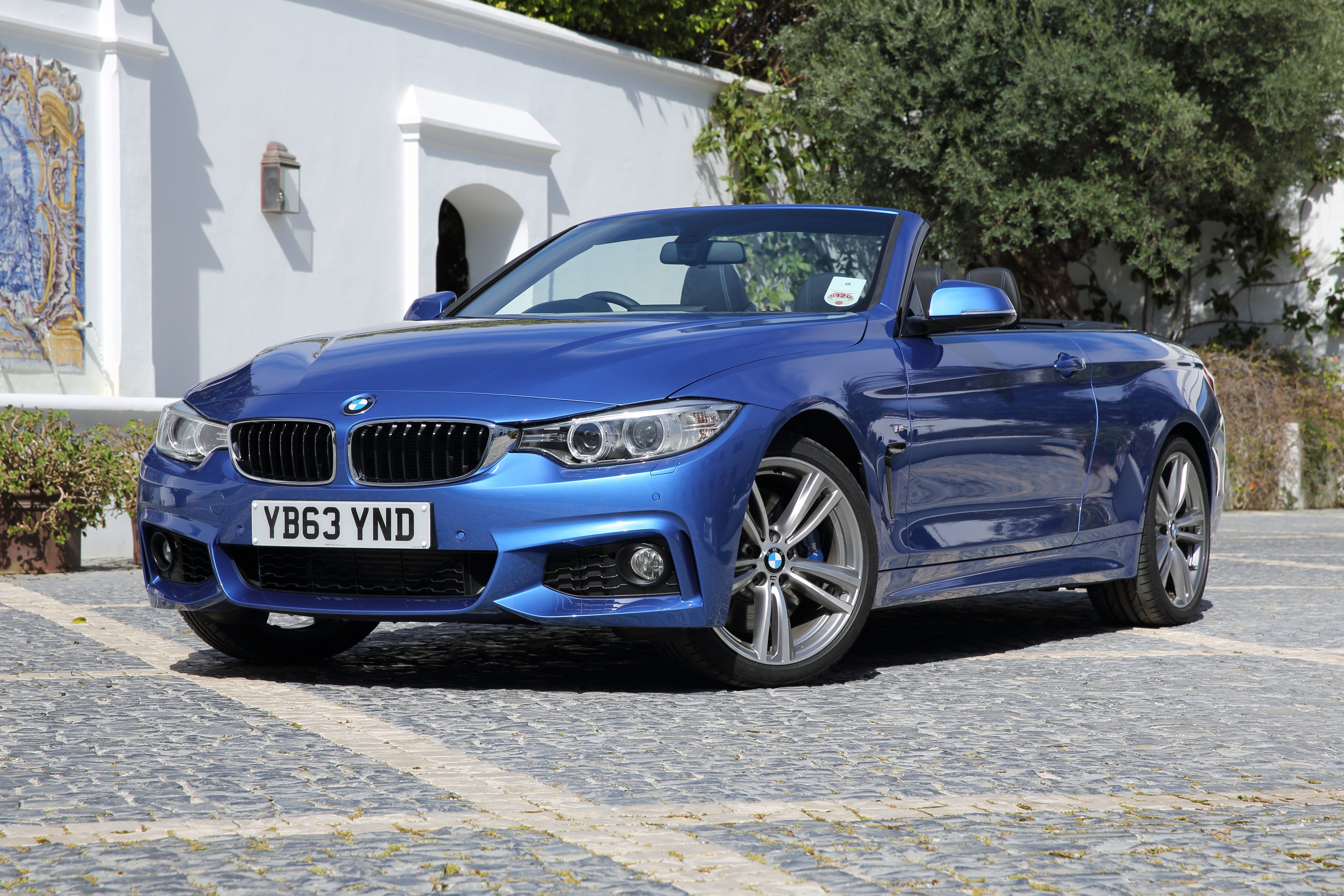BMW 4 Series Convertible (2014-2020) Review
Written by Andrew Brady
Quick overview
Pros
- Folding metal roof boosts security and refinement
- Rides better than 4 Series Coupe, and handles just as well
- Interior feels well made and has impressive tech
Cons
- Limited space in the rear seats and boot
- Excellent automatic gearbox not standard on all engines
- Complex roof is expensive to fix if it fails
Overall verdict on the BMW 4 Series Convertible
"In this BMW 4 Series Convertible review we are looking at one of the most desirable premium drop-tops on the market. As well as offering the open-air experience and attractive design you expect from a convertible, it still drives like a BMW should and can even be quite cheap to fuel if you choose the appropriate engine. What's not to like?"
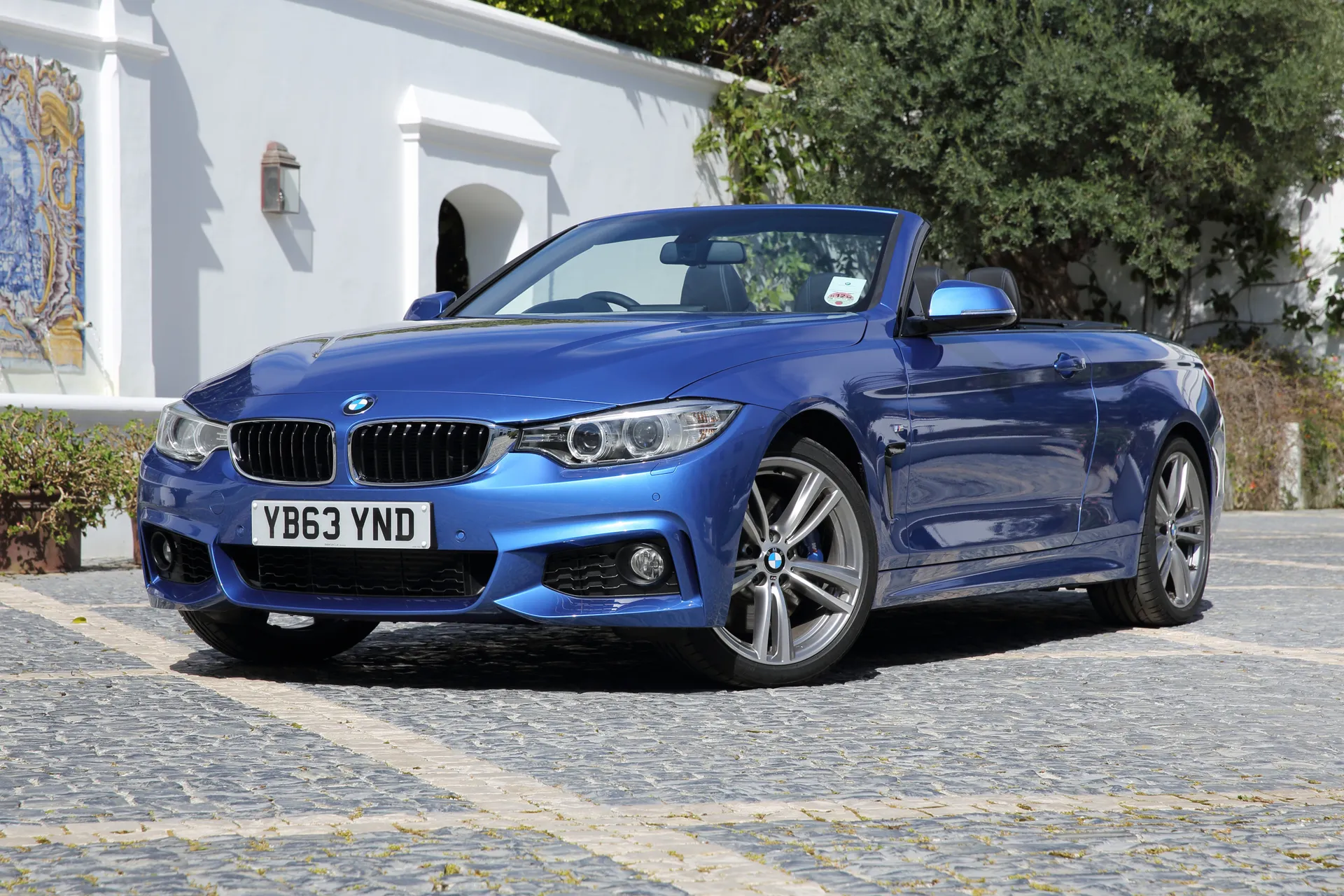
Having a solid hunk of metal above your head, rather than a piece of material, does bring obvious benefits. It makes a car more secure, and tends to do a better job at keeping outside noises from the cabin. Clever stylists can also make a car look almost identical to a coupe version – something the BMW 4 Series Convertible manages to achieve. It's also one of the best convertible cars going. We will explain all in our BMW 4 Series Convertible review.
With the roof of the 4 Series up, it will take a seasoned BMW spotter to notice it isn't the more common BMW 4 Series Coupe. This can only be a good thing, as the BMW 4 Series is a genuinely handsome car, and one that looks good with the roof raised or lowered.
The downside of a folding metal roof is that it adds cost and complexity compared to a simpler fabric affair. There is also the additional weight from the various bits of glass and metal, along with an increased chance of expensive repairs should something break. This is partly why they have fallen from favour, with most now reserved for high-end supercars.
BMW has managed the extra weight of the folding metal roof well in the BMW 4 Series Convertible. A range of powerful petrol and diesel engines means even the cheapest models feel relatively quick, and all benefit from BMW’s skill for building cars that are fun to drive. Running costs are reasonable, with fuel consumption and VED (road tax) kept in-check on smaller-engined cars.
Most versions come with rear-wheel drive, but four-wheel drive is found on certain models. This adds an extra level of reassurance in winter weather. A manual gearbox is standard with most engines, with the option of an eight-speed automatic.
Standard levels of equipment are good, with even basic SE cars featuring 17-inch alloy wheels, xenon headlights, climate control and leather seats. Naturally, there is the temptation to move further up the food chain, with top-spec M Sport cars benefiting from sports suspension, fancier body styling and upgraded infotainment.
The folding metal roof makes the BMW 4 Series Convertible feel refined when raised, aided by a more comfortable ride than the Coupe version. However, the roof does eat into boot space quite dramatically, and rear passengers will not feel enthusiastic about the space they have either.
Capable of being used every day around town, the BMW 4 Series Convertible is also at home cruising the motorway. It is well suited to the daily commute or a weekend away, enjoying the unlimited headroom of a convertible.
There is a lot to like about the BMW 4 Series Convertible. Handsome looks, the benefits of a folding metal roof, agile dynamics and a premium badge all make it an attractive package.
If you're looking for the classic version, you need our BMW 4 Series review.
Is the BMW 4 Series Convertible right for you?
Undoubtedly, the defining feature of the BMW 4 Series Convertible is its folding metal roof. Compared to cars with a fabric soft-top, the 4 Series scores points for improved security and better levels of noise insulation.
Yet the BMW 4 Series Convertible is more than just a fancy roof. It looks stylish, rides and handles with self-assurance, plus has the benefit of a premium German badge on the bonnet.
It should appeal to those who like the idea of an open-top car, but want to use it all year round. In addition, those who have to park on the street will appreciate the improved security of the metal top. Only space in the boot, and a lack of legroom for rear passengers, could prevent it being a winner for most.
What’s the best BMW 4 Series Convertible model/engine to choose?
The BMW 4 Series Convertible range attempts to cover most bases, from buyers who want ultimate luxury to those in need of something sportier. With the wide array of engine and trim combinations, there should be a version to suit you.
The 435d diesel engine impresses if you are doing big miles. It comes with xDrive four-wheel drive as standard, and delivers a mighty 313PS. That’s good enough for 0-62mph in around five seconds, yet can also achieve up to 44mpg.
If a petrol suits your needs better, the 428i four-cylinder (later replaced by the 430i) offers a good blend of power and frugality. Whatever the engine, we would plump for the eight-speed sport automatic gearbox over the manual.
M Sport trim offers decent value for money, along with sportier styling. Even the standard sports suspension does not upset ride quality hugely.
What other cars are similar to the BMW 4 Series Convertible?
With the demise of cars like the Volvo C70 and Volkswagen Eos, four-seater cabriolets with a folding metal roof are in short supply. Unless your budget stretches to a Ferrari Portofino, the BMW 4 Series Convertible really is your only option.
The Audi A5 Cabriolet and Mercedes-Benz C-Class Cabriolet are closer rivals. Both offer premium badges and classy styling, but also make do with fabric roofs. Space in the back of the Audi and Mercedes is also limited, just like the 4 Series.
Choosing between the three is tricky, with the BMW offering the best driving experience. However, the Mercedes C-Class is more comfortable, while the Audi A5 has the nicest interior design.
Comfort and design: BMW 4 Series Convertible interior
"The front half of the BMW 4 Series Convertible interior is the same as that in the Coupe. It also draws a great deal of inspiration from other BMW models across the range. That’s not necessarily a bad thing – just don’t go expecting exciting design."
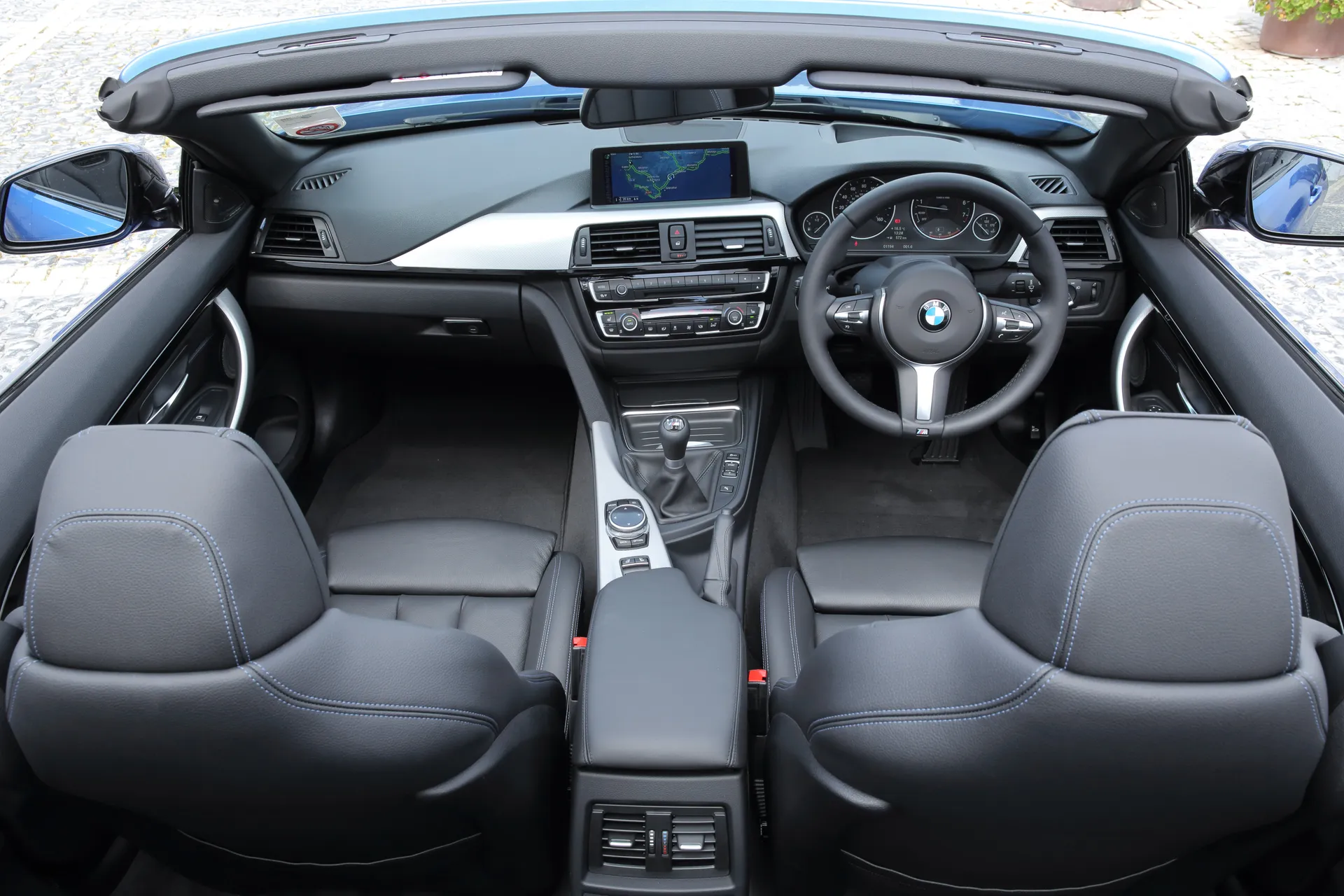
The layout makes sense and is focused on the driver. Compared with newer cars there are quite a lot of buttons peppered across the dashboard, with a large multimedia screen at the top. Rivals might do things with more pizzazz, but the interior of the BMW 4 Series Convertible is easy to live with.
Getting comfortable in the front is made easier by electric adjustment being standard for both driver and passenger. The seating position is low to the ground, helping emphasise the sporty nature of the car. There is also a memory function for the driver’s seat, although adjustable lumbar support has to be specified from the options list.
All trim levels above SE come with sports seats as standard, which are notably more supportive – a good argument for skipping the entry-level model. Back-seat passengers will feel less comfortable due to the upright design of the rear bench. Legroom is also restricted by the front seats, while headroom suffers when the roof is raised. Children and smaller adults will be OK for short journeys, but anyone over six feet will feel cramped.
Quality and finish
It may not be the most exciting interior design, but there should be no concerns about how well put together the BMW 4 Series Convertible is.
The trim feels made to last, and you will need to search hard to find anything that feels like it was built down to a cost.
All of the usual touchpoints are made from expensive-feeling materials. The steering wheel in M Sport cars is especially nice to hold, and comes complete with multi-function buttons. A heated steering wheel appears on the options list, and could be handy for going topless on chillier days.
Regardless of the level of trim chosen, Dakota leather upholstery is fitted to all BMW 4 Series Convertibles. Fancier versions have a greater choice of leather colours, but all make it feel luxurious on the inside.
The various trim levels present a myriad number of interior finishes for the dashboard and centre console. These range from satin silver on entry-level SE cars to anthracite wood and gloss back on Luxury and Sport models. Range-topping M Sport versions use a hexagonal aluminium finish.
Infotainment: Touchscreen, USB, nav and stereo in the BMW 4 Series Convertible
BMW’s iDrive system is now almost two decades old, and the company has refined and updated it considerably since it was first introduced. It should become easy to use with familiarity.
Lower trim levels come with a 6.5-inch screen atop the dashboard, whereas M Sport models feature a bigger 10-inch display. This can also be added to other cars as part of the optional BMW Professional package, and is something worth looking out for on used models.
Satellite navigation comes as part of the BMW Business media package, which is standard on Luxury and M Sport models.
All cars come with a DAB radio, along with Bluetooth mobile phone connectivity and USB ports. BMW still charges extra to add Apple CarPlay to its cars, however, and the BMW 4 Series Convertible was no different. It can only be found on later models with the Professional or Professional Plus media packages.
This is all operated by the iDrive rotary controller, mounted on the centre console. There are also controls mounted on the steering wheel, while voice commands are included with certain packages.
Space and practicality: BMW 4 Series Convertible boot space
Like the competing Audi A5 and Mercedes-Benz C-Class, BMW describes the 4 Series as being a four-seater convertible. The reality is slightly different, though.
Those in the front of the BMW are unlikely to have any complaints about the space on offer. With a wide range of adjustment from standard electrically adjustable front seats, there should be no issues with getting comfortable. Headroom is great with the roof in place, and obviously becomes unlimited with it retracted.
Unlike its competitors, a sliding armrest is not standard across the range. It’s a strange omission given the minimal cost of adding it to the car.
In the rear, passengers are less likely to be content with their lot. Legroom is particularly limited for those beyond child size, meaning the 4 Series functions as a four-seater in name only. Head and shoulder room are at least acceptable in the back, while child seats will also fit without an issue. Should you install the optional wind deflector, however, the rear seats will become completely unusable.
Having a hard-top roof, made from glass and metal panels that fold elegantly together, certainly makes for an impressive sight. However, storing it needs plenty of space, as it cannot be safely squashed down like a fabric top.
To keep a clean look for the rear decklid, all these components disappear into space usually reserved for the boot. It means the standard 370-litre boot capacity drops to just 225 litres with the top down. That is the difference between having a boot on par with a family hatchback, then compressing it to one found in a city car.
It means you will need to pack sparingly, should you want to use the BMW 4 Series Convertible for weekends away and still drop the roof. Given the limited space in the back seats, using them to store luggage is another option. A ski hatch is standard to help load longer items, although folding rear seats are relegated to the options list.
The BMW 4 Series Convertible dimensions are 4638mm long, 2017mm wide and 1384mm tall.
Handling and ride quality: What is the BMW 4 Series Convertible like to drive?
"Describing a BMW as having good handling is a cliche, but the 4 Series Convertible proves that some tropes ring true. It is certainly sportier to drive than its German rivals, and offers keen drivers plenty of fun."
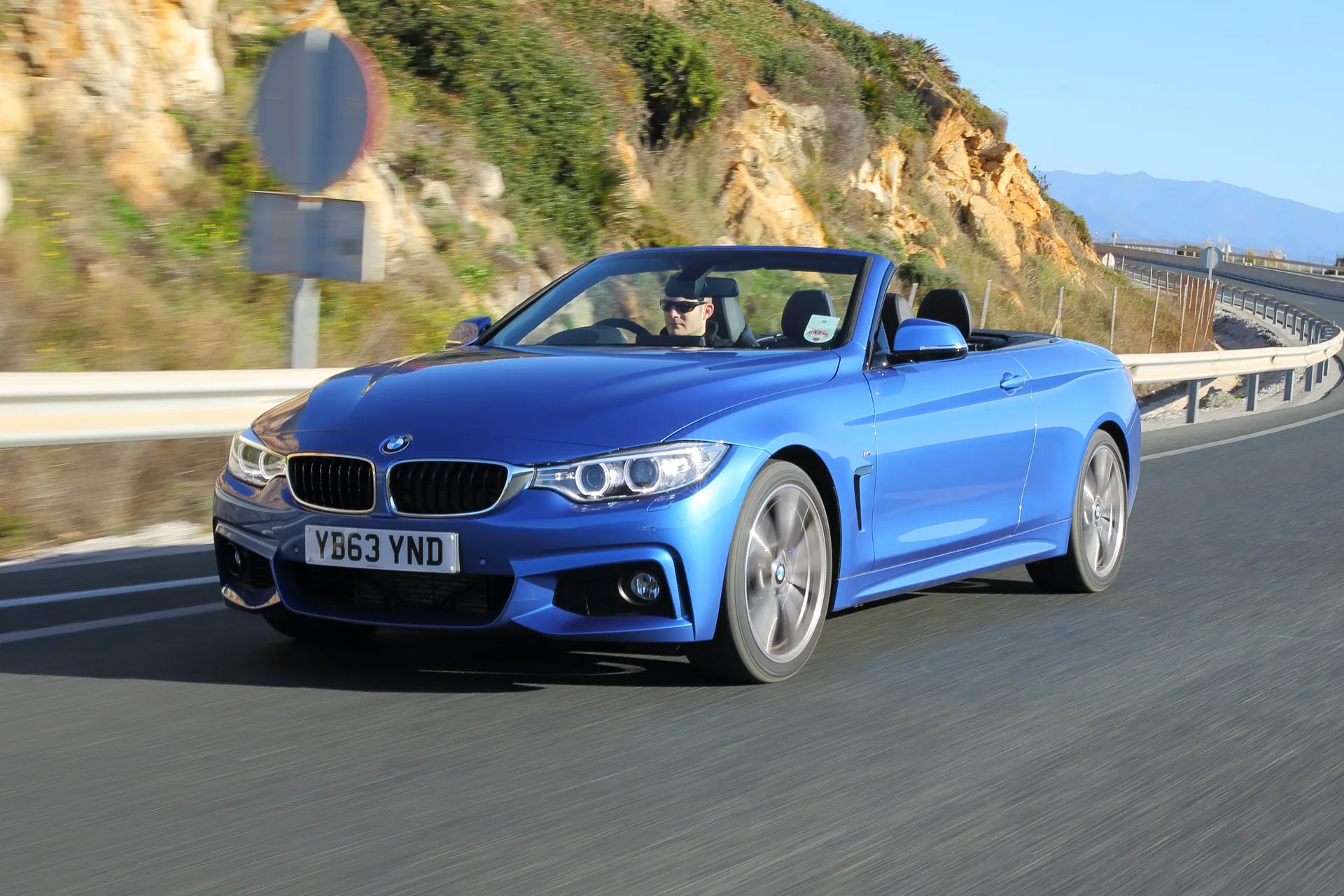
There are limitations to keep in mind, though. Compared with the BMW 4 Series Coupe, the transition to a convertible with a folding metal roof adds more than 200kg of extra weight. Some of this comes from the roof itself, with the rest the result of additional strengthening to keep everything feeling solid.
This has the benefit of making the BMW 4 Series Convertible feel taught on the road, with little of the wobbling often associated with cabriolets. It might not feel quite as sporty as the 4 Series Coupe, but tackling twisty roads will still be enjoyable.
BMW’s Servotronic adaptive power steering is fitted to all models, whilst Variable Sport Steering is available as an option. The standard steering is accurate and well weighted, although it does not deliver huge amounts of feel. For most drivers this won’t really matter, as the BMW 4 Series Convertible makes more sense as a relaxed cruiser.
What impresses more is how well BMW made the car ride. For a car that leans towards performance, with a stiff chassis, the manner in which it copes with rough roads is a revelation.
Even M Sport models, fitted with uprated sports suspension, manage to feel relatively comfortable across bumps and potholes. This is one area where the BMW 4 Series Convertible actually scores better than the Coupe version, which can feel less settled.
Cars with the optional Adaptive M Sport Suspension are worth seeking out, as this offers a greater range of adjustment. The flick of a switch allows the driver to change between Comfort and Sport modes.
What engines and gearboxes are available in the BMW 4 Series Convertible?
BMW launched the BMW 4 Series Convertible in 2014 with a limited selection of engines, but expanded the options over time.
Petrol choices start with the 420i 2.0-litre four-cylinder turbo, producing 184PS and capable of 0-62mph in 8.2 seconds. It will be sufficient for most drivers, but those in need of outright pace need to look elsewhere.
Salvation may come with the 428i, another turbocharged 2.0-litre four-cylinder engine producing 245PS. BMW later replaced this with the 430i in 2016, taking power to 252PS. It can reach 62mph in 6.3 seconds, and feels much more lively.
Top dog in the petrol range is the 3.0-litre turbocharged straight-six. Originally badged 435i, it offers an impressive 306PS. In 2016, it was boosted further to 321PS in the 440i, with the 0-62mph time falling to 5.4 seconds. Expect big running costs, though.
Diesel engines kick off with the 420d, which offers 190PS after 2016 and acceleration from 0-62mph in 8.1 seconds, the extra torque making it feel quicker than the 420i.
A 224PS 425d four-cylinder diesel was added in 2016, then rebranded as the 430d in 2017 with 258PS. It offers more acceleration, but might be overlooked in favour of the impressive 435d.
With 313PS from its twin-turbocharged straight-six, the 435d rockets from 0-62mph in 5.2 seconds. Standard xDrive four-wheel drive helps control the power, with the biggest diesel still able to offer up to 44mpg.
Originally, a six-speed manual gearbox was standard for most models, although this was later phased out, making the eight-speed automatic the only choice. The 430d, 435d and 440i can only be had with the automatic.
Refinement and noise levels
The issue of refinement is where the extra weight and complexity of the folding metal roof begin to pay dividends.
While many modern cabriolets with fabric soft-top roofs are quiet, they cannot come close to a tin-top rival. The metal roof of the BMW 4 Series Convertible makes it just as refined as the regular Coupe when raised, shutting out noise from the road.
BMW worked hard to make the 4 Series as aerodynamic as possible, which also helps improve overall refinement. Wind noise is minimal with the roof up, yet still well controlled with it lowered. Go top-down and you should still be able to hold a conversation at motorway speeds.
Those in the front will notice only minimal levels of buffeting with the roof down, although rear seat passengers will be more aware of draughts. Fitting the optional wind deflector will make front occupants even more comfortable, but also makes the back seats completely unusable.
An important optional feature on the BMW 4 Series Convertible is the Air Collar system. This uses heater vents built into the seats to blow warm air across the neck of the driver and front-seat passenger. It works remarkably well, making it possible to use the 4 Series with the roof down even when it is chilly outside.
The Air Collar comes as part of the Convertible Comfort package. This includes the previously mentioned rear wind deflector, plus a heated steering wheel to further the BMW’s winter credentials.
One thing to remember with the folding roof is that it takes 20 seconds to raise or lower. Also, unlike its rivals, it can only be done at speeds of up to 8mph. This means you will have to pull over quickly should you get caught in a sudden rainstorm with the top down.
Safety equipment: How safe is the BMW 4 Series Convertible?
Although the BMW 4 Series Convertible has not been formally tested by Euro NCAP, the related 3 Series scored the maximum five stars when evaluated. We imagine the 4 Series would perform just as well should the worst happen.
A host of airbags are standard in the BMW 4 Series Convertible, along with rollover protection. This detects if the car is about to flip, and deploys pop-up roll bars to keep the occupants safe. Stability control and traction control are also fitted as standard.
Parking sensors for both the front and rear are fitted to all models, helping slot into the tightest spaces. A reversing camera could be optioned as part of the Advanced Parking pack, which also includes Park Assist. Later cars also had the option of a full surround-view camera.
An optional Driving Assistance Package brings more safety technology to the party. This includes Forward Collision Warning and Lane Departure Warning. Xenon headlights were fitted to all BMW 4 Series Convertibles from launch, complete with headlight washers. An update in 2016 would see these replaced with full LED headlights instead, along with LED fog lights for all cars.
The two rear seats come fitted with ISOFIX attachment points, allowing child seats to be fitted safely and securely. BMW uses run-flat tyres across the BMW 4 Series Convertible range, meaning there is no spare wheel included.
MPG and fuel costs: What does a BMW 4 Series Convertible cost to run?
"As a sporty cabriolet, fuel economy might not be the most important consideration for buyers looking at a BMW 4 Series Cabriolet. However, nobody likes to pay more than necessary, so these are the most efficient engine options available."
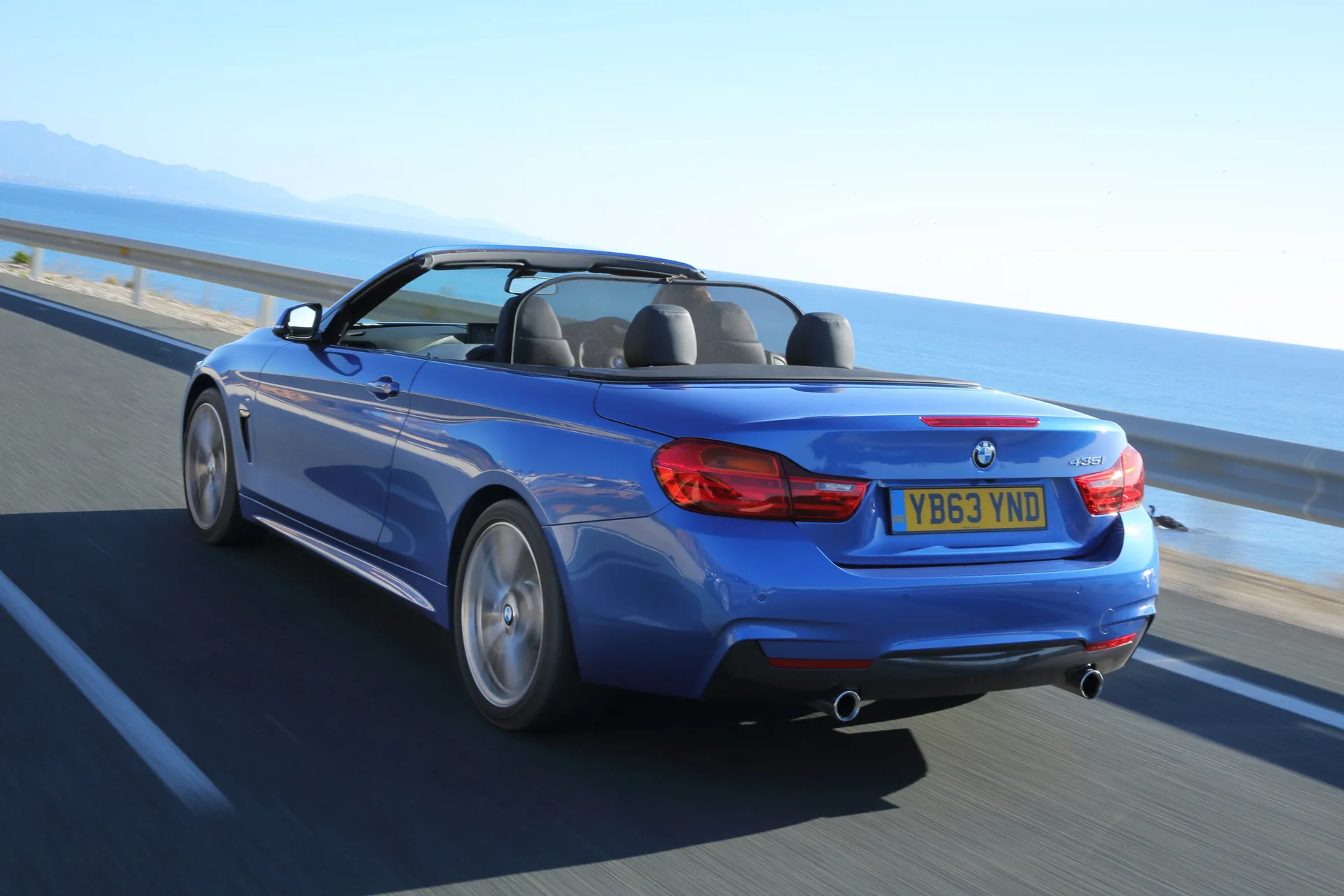
In terms of petrol options, the 420i is the least powerful and most efficient. Fitted with the smaller 17-inch alloy wheels and an automatic gearbox, the 420i SE can achieve up to 48.7mpg.
For those doing longer journeys, and who want maximum economy, the diesel 420d is the best choice. The 420d SE, also with 17-inch wheels and an automatic ’box, manages an impressive official figure of 64.2mpg.
How reliable is a BMW 4 Series Convertible?
The BMW 4 Series (including the Convertible and Coupe variants) achieved a strong 9.43 out of 10 for reliability in the HonestJohn.co.uk Satisfaction Survey, making it one of the better-performing BMWs. As with any convertible car it's worth ensuring that the roof is operating correctly and has been regularly used - keeping it closed all the time causes more problems than exercising the folding mechanism once in a while.
As a brand BMW finished a relatively disappointing 20th overall out of 30 manufacturers, although its overall reliability score was also good.
Insurance groups and costs
Being a desirable car with a premium badge and strong performance, insurance costs are always going to be at the higher end of the scale. Naturally, the BMW 4 Series Convertible is a car aimed at more experienced drivers.
The 420i in SE or Sport trim should be the cheapest to insure, rated at group 30 out of 50. M Sport trim pushes this to group 31 with the same engine. At the other end of the petrol scale, the 440i M Sport is (a relatively reasonable) group 40.
In terms of diesels, the 420d was originally rated as group 31, although this was revised upwards following the 2017 facelift. This change pushed the 420d M Sport to group 34.
VED car tax: What is the annual road tax on a BMW 4 Series Convertible?
Having been introduced in 2014, the BMW 4 Series Convertible straddles different VED (road tax) regimes. It means two identical cars registered just days apart could have radically different costs, so be sure to check carefully.
Earlier examples of the 420d SE fall inside the bracket of £30 per year. This is limited to models with 17-inch alloy wheels and the optional automatic gearbox, which produce 116g/km of CO2. It means these cars have the cheapest VED across the range.
Be aware that many later models had a list price above £40,000. This means they incur an additional £355 surcharge on top of the £165 annual VED rate. The is due for five years after the first year of registration. Benefit-in-kind company car tax rates range from 33% for the 420i SE through to 37% for the 440i M Sport.
How much should you be paying for a used BMW 4 Series Convertible?
"The BMW 4 Series Convertible has proven popular with buyers, meaning there is a plentiful supply on the used market."
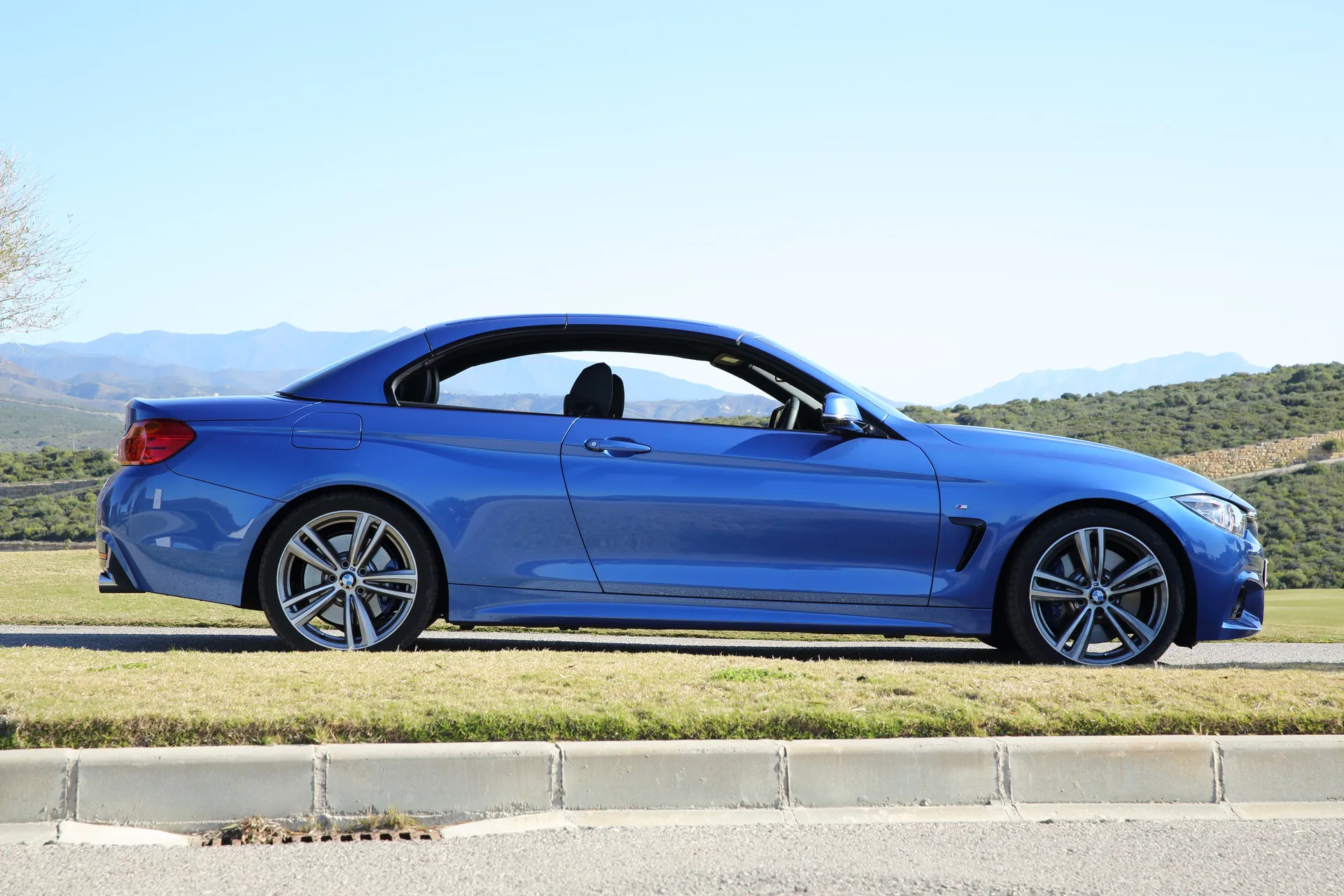
M Sport models are most popular by a substantial margin, so you will need to be prepared to hunt down an SE or Sport should you want one. Finding a car with a manual gearbox will also be hard work, so common are automatics.
Diesel versions are in greater supply, with the 420d particularly easy to find. A 420d M Sport with around 20,000 miles on the odometer should cost from £25,000. The most recent cars with minimal mileage will be closer to £30,000. Should you want a petrol 420i, nearly-new examples of M Sport cars begin at £25,000.
Trim levels and standard equipment
BMW changed the trim levels during the lifespan of the 4 Series Convertible, meaning not all were available consistently. BMW 4 Series Convertible SE models have 17-inch alloy wheels, dual-zone climate control, a DAB radio, leather seats, and exterior trim in matt aluminium. BMW 4 Series Convertible Sport adds 18-inch alloy wheels, gloss black trim for the front and rear bumper inserts, sports seats and a Drive Performance Control switch.
BMW 4 Series Convertible Modern specification was only available until May 2014, but featured 18-inch wheels, matt chrome exterior trim and ambient interior lighting. The BMW 4 Series Convertible Luxury trim level existed until July 2017, with 18-inch wheels, chromeline exterior trim, satellite navigation and anthracite wood interior trim.
Finally, BMW 4 Series Convertible M Sport models bring 18-inch alloy wheels, bespoke M body styling, an M Sport steering wheel, sports seats, M Sport suspension and black headlining. The M Sport trim level represents good value for money – and gives the 4 Series more presence on the road.
Ask the heycar experts: common questions
How much is the BMW 4 Series Convertible?
Does the BMW 4 Series come in a convertible?
Is the BMW 4 Series Convertible a soft top?
Get our latest advice, news and offers
Keep me updated by email with the latest advice, news and offers from heycar.
By submitting you agree to our privacy policy
